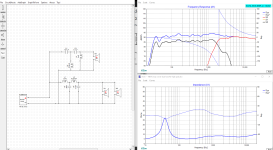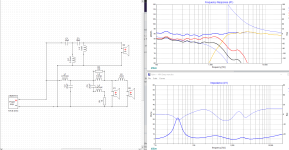The impedance correction need to go across the woofers after the filter, not before. The reason for use is to compensate for the woofers inductance, and bring the impedance to a near omic (flat) response, this in order for the filter to work as intended ...These aren't the calculated values but wouldn't this push the overall impedance too low?
When designing the filter you should try to do the filter for each driver separately first, to ensure it follows a good target (e.g. 3. order high pass). You can put in a target curve to match the filter to.
I'm always quite amazed of how much the impedance response plays a role in the crossover region ....
With modern amps (not tubes), don't worry too much on the load ..
Well, I think you have me convinced crossing from a 8 to a ribbon isn't the best idea. I am gravitating toward WTW. I swapped out the ribbon for a 1 1/8 HiVi dome tweeter. Here are the results. I am still working on getting the rise in frequency at the crossover down.
Attachments
I hate to be a party-pooper, but why are the woofers tied together on the same filter circuit? In real life they will always be slightly different, and located in different positions on the box, so there's a chance of resonances, e.g. microphonic voltages from 1 woofer will drive the 2nd woofer and vice versa. But if they are given separate filters, the damping should be better. I'm just simulating it in my mind, so try it both ways and see if you hear a difference.
Last edited:
I would explore a TWW 2.5 way crossover. This might help put your tweeter at ear level unless you want a tall box
why are the woofers tied together on the same filter circuit? In real life they will always be slightly different, and located in different positions on the box, so there's a chance of resonances, e.g. microphonic voltages from 1 woofer will drive the 2nd woofer and vice versa.
And I can say that makes operation of two drivers more uniform, beacuse they are in better electrical interaction.
Will you use individual or shared xo parts for two drivers working in parallel is just matter of preference. Both ways are ok.
I would still keep an eye out for microphonic signals being picked up such as break-up modes, where the efficiency is highest in both directions (converting from electrical to mechanical, and from mechanical to electrical). Keeping the woofers separate means that spurious electrical signals would have to pass through 2 sets of filters and the amplifier voltage source before reaching the other woofer.
A 'hifi' driver with very low sensitivity and no break-up peaks may be OK, but I'd expect that as sensitivity goes up, these sort of side-effects would increase and 2 sets of parallel filters (or even bi-amping) would work better.
A 'hifi' driver with very low sensitivity and no break-up peaks may be OK, but I'd expect that as sensitivity goes up, these sort of side-effects would increase and 2 sets of parallel filters (or even bi-amping) would work better.
- Home
- Loudspeakers
- Multi-Way
- Crossover design for dual woofer 2 way

